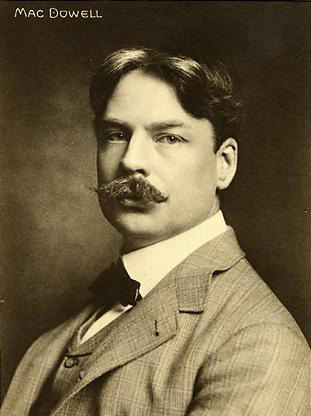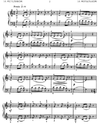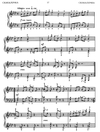
An étude or study is an instrumental musical composition, usually short, designed to provide practice material for perfecting a particular musical skill. The tradition of writing études emerged in the early 19th century with the rapidly growing popularity of the piano. Of the vast number of études from that era some are still used as teaching material, and a few, by major composers such as Frédéric Chopin, Franz Liszt and Claude Debussy, achieved a place in today's concert repertory. Études written in the 20th century include those related to traditional ones and those that require wholly unorthodox technique.

Anton Stepanovich Arensky was a Russian composer of Romantic classical music, a pianist and a professor of music.

Edward Alexander MacDowell was an American composer and pianist of the late Romantic period. He was best known for his second piano concerto and his piano suites Woodland Sketches, Sea Pieces and New England Idylls. Woodland Sketches includes his most popular short piece, "To a Wild Rose". In 1904 he was one of the first seven Americans honored by membership in the American Academy of Arts and Letters.

Franz Xaver Wolfgang Mozart, also known as Wolfgang Amadeus Mozart, Jr., was the youngest child of six born to Wolfgang Amadeus Mozart and his wife Constanze and the younger of his parents' two surviving children. He was a composer, pianist, conductor, and teacher of the late classical period whose musical style was of an early Romanticism, heavily influenced by his father's mature style. He knew Franz Schubert and Robert Schumann, both of whom held him in high esteem.

Yevgeny Kirillovich Golubev was a Soviet and Russian composer.

Sergei Mikhailovich Lyapunov was a Russian composer, pianist and conductor.

Frédéric Chopin wrote a number of preludes for piano solo. His cycle of 24 Preludes, Op. 28, covers all major and minor keys. In addition, Chopin wrote three other preludes: a prelude in C♯ minor, Op. 45; a piece in A♭ major from 1834; and an unfinished piece in E♭ minor. These are sometimes referred to as Nos. 25, 26, and 27, respectively.

Levko "Lev" Mykolajovych Revutskyi was a Ukrainian composer, teacher, and activist.

Vasyl Oleksandrovych Barvinsky was a Ukrainian composer, pianist, conductor, teacher, musicologist, and music related social figure.
Harry Farjeon was a British composer and an influential teacher of harmony and composition at the Royal Academy of Music for more than 45 years.

Mélanie Hélène Bonis, known as Mel Bonis, was a prolific French late-Romantic composer. She wrote more than 300 pieces, including works for piano solo and four hands, organ pieces, chamber music, mélodies, choral music, a mass, and works for orchestra. She attended the Paris Conservatoire, where her teachers included Cesar Franck, Ernest Guiraud, and Auguste Bazille.

Thomas Frederick Dunhill was a prolific English composer in many genres, though he is best known today for his light music and educational piano works. His compositions include much chamber music, a song cycle, The Wind Among the Reeds, and an operetta, Tantivy Towers, that had a successful London run in 1931. He was also a teacher, examiner and writer on musical subjects.

Viktor Kalabis was a Czech composer, music editor, musicologist, and husband of harpsichordist Zuzana Růžičková.

Viktor Stepanovych Kosenko was a Ukrainian composer, pianist, and educator. He was regarded by his contemporaries as a master of lyricism. His first compositions were markedly influenced by the works of composers such as Alexander Scriabin, Pyotr Ilyich Tchaikovsky, Sergei Rachmaninoff, and his compatriot Mykola Lysenko.

Andrey Rafailovich Kasparov is an Armenian-American pianist, composer, and professor, who holds both American and Russian citizenship.

Johannes Brahms' Liebeslieder Waltzes (Liebeslieder-Walzer) are distributed across two opus numbers: Op. 52 and Op. 65. The waltzes are a collection of love songs in Ländler style for voices and piano four hands. The lyrics for the Liebeslieder come from Georg Friedrich Daumer's Polydora, a collection of folk songs and love poems. While there is no concrete record indicating the exact inspiration for the Waltzes, there is speculation that Brahms' motivation for the songs was his frustrated love for pianist and composer Clara Schumann.
Eleven Études in the Form of Old Dances, Op. 19, written specifically for educational purposes between 1928 and 1930 by Ukrainian pianist and composer Viktor Kosenko, is a late-romantic collection of solo piano pieces mingled with elements of Ukrainian folk-like melodies, using French-baroque dance forms such as minuet, allemande, courante, sarabande, and gavotte as concept.
In music, Op. 25 stands for Opus number 25. Compositions that are assigned this number include:






























































